Ron Stultz
"Electrostatic Air Cleaner (Trion, Inc): Broken Ionizing Wire"

Summary: Ionizing wires are made out of tungsten and near impossible to break. Problem with wire is hunk of brass crimped to each end comes loose and wire can not be reattached. New wires available over the Internet but a do-it-yourself (DIY) solution works if you have the tools and time.
Background:
Have 2 Trion electrostatic air cleaners installed in home.
Both units now 25 years old.
Most recently removed collector cells from larger, MAX5 unit and found missing ionizing wires.
Examination of tungsten wire revealed that wire had come loose from crimped brass or other metal, end.
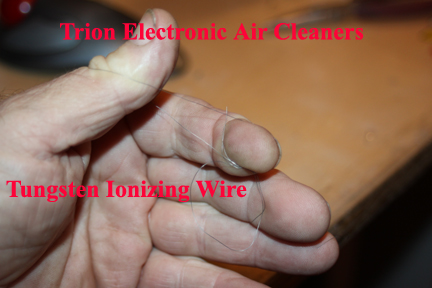
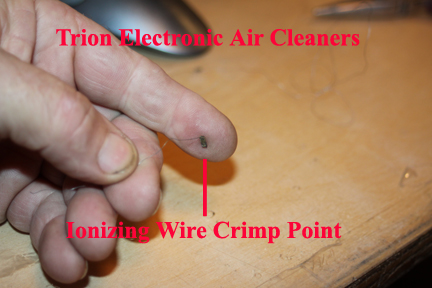
Tungsten wire is very strong in tensile strength and nearly impossible to break, so culprit is crimped ends.
Researching Internet revealed ionizing wires available for Trion air cleaners but $7 a wire and probably have poorly implemented end crimps.
I you not familiar with handling or working with wire or a soldering iron, suggest you buy replacement and install.
If you buy and install, be especially careful handling both ends because crimped end can easily be pulled loose.
For those with some experience doing home electrical wiring or other circuit wiring below is a DIY method, I found works.
Note on Tungsten Wires:
Tungsten wire was probably used because the very small diameter wire creates the most ions and tungsten being so strong was a perfect choice.
Your air cleaner will work if you only have 1 or 2 missing ionizing wires. Not as well if all wires are present but it will work.
In my case, one collector cell had 5 missing wires.
Each collector cell in a Max5 unit has a total of 14 ionizing wires.
No matter if you replace wires or simply use unit with missing wires, ensure no wire fragment is in unit and potentially shorting out touching a large or small metal plate.
Do-it-yourself:
Understand that tungsten wire probably the best to use as a replacement wire but did not have any, so used 22 gauge stranded steel wire as a replacement.
Tried cooper because better conductor than steel but just too soft to work with (limited tensile strength).
22 gauge stranded wire larger in diameter than original tungsten wire but fits properly in groove cut into charged metal support.
The 22 gauge steel stranded wire I had was insulated so had to strip off insulation.
Once I had bare steel wire, cut a length 4 inches longer than distance between supports in collector cell.
Starting at one end, wrapped steel stranded wire around support and then using needle nose pliers twist wire to make a strong junction.
In routing wire around support, made sure it was not and could not touch any metal plate.
One junction tight, soldered wire and cut off any excess from junction.
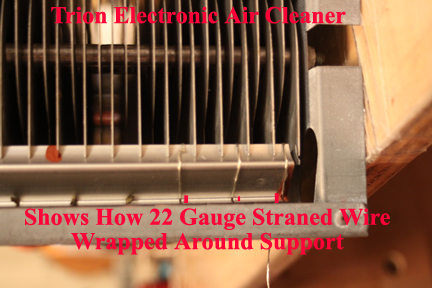
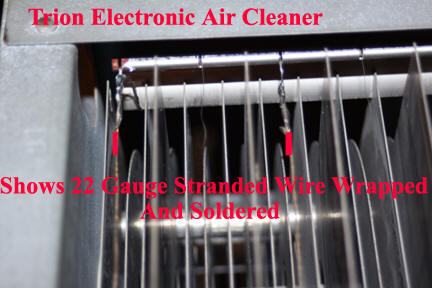
Then took free end of 22 gauge stranded steel wire and stretched it tight and fit into groove on opposite support, wrapped end of wire around structure and again wrapped wire around itself to make a tight junction and soldered. Cut excess wire from junction.
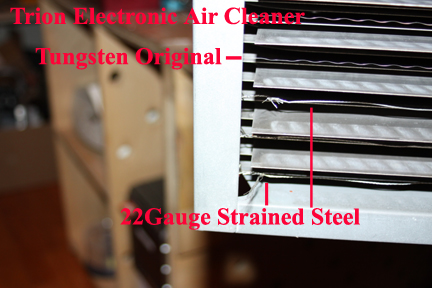
Inserted collector coils back into Trion unit and it works. Sure steel stranded not creating ions as much as smaller diameter tungsten but something is better than nothing.
Perhaps one day I will buy spool of tungsten wire and do over. Suspect tungsten wire so strong, not going to be easy to create wrapped junction at either end.
Spool of tungsten wire cost about $10 and probably enough to replace every wire in the Max5 collector cell.